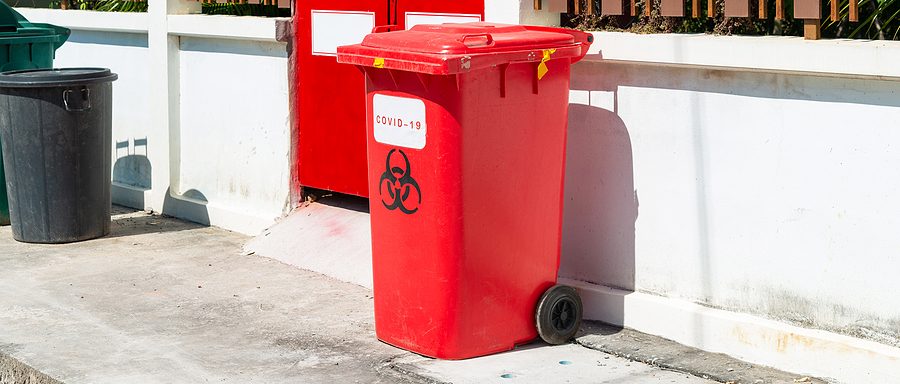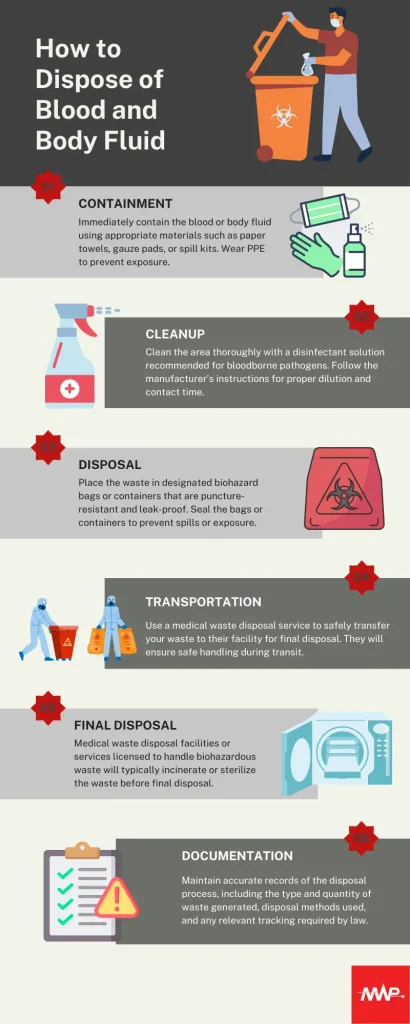How to Dispose of Blood and Body Fluids

Proper disposal of blood and body fluids is not only essential for maintaining a safe and hygienic environment but also plays a critical role in preventing the spread of infectious diseases. Whether you’re in a healthcare setting, dealing with a household accident, or simply seeking to understand best practices, knowing how to handle and dispose of these substances is necessary. In this comprehensive guide, we’ll delve into the importance of proper disposal methods, explore the regulations surrounding it, and provide practical tips to ensure you manage blood and body fluids safely and responsibly.
Are All Body Fluids Considered Medical Waste?
Medical waste encompasses a wide range of waste types. One important type of medical waste is items contaminated with body fluids. These materials are considered biohazardous waste, and there are local and state regulations regarding the safe handling and disposal of these waste items.
Why Are Body Fluids Dangerous?
The human body produces many different types of fluids as a part of normal human function. However, many bodily fluids can easily transmit serious communicable diseases, such as HIV and Hepatitis B, when a person comes into contact with them. All body fluids containing suspected or visible blood traces are considered hazardous, even if they are otherwise low-risk fluids.
High-Risk vs. Low-Risk Fluids
Not all bodily fluids carry the same infectious risk. According to Universal Precautions, certain bodily fluids are more likely to be hazardous. High-risk bodily fluids include:
- Blood
- Any low- or high-risk fluid with visible blood
- Synovial fluid
- Pericardial fluid
- Pleural fluid
- Vaginal secretions
- Semen
- Cerebrospinal fluid
- Amniotic fluid
Low-risk bodily fluids may not carry the same risk of infection. These fluids include:
- Saliva
- Sweat
- Feces
- Vomit
- Tears
- Urine
However, any low-risk fluid with any visible blood traces is then considered a high-risk fluid. Low-risk bodily fluids are also treated as high-risk if it is impossible to determine whether fluids are mixed or what types of fluids are present. All bodily fluids generate medical waste.

How to Properly Dispose of Blood and Body Fluids
The disposal of blood and body fluids typically involves several steps to ensure safety and compliance with regulations. Here’s a general overview of the process:
- Containment: Immediately contain the blood or body fluid spill using appropriate absorbent materials such as paper towels, gauze pads, or spill kits. Wear personal protective equipment (PPE) such as gloves, goggles, and a face mask to prevent exposure.
- Cleanup: Clean the area thoroughly with a disinfectant solution recommended for bloodborne pathogens. Follow the manufacturer’s instructions for proper dilution and contact time.
- Disposal: Dispose of biohazardous waste according to local regulations. This may involve placing the waste in designated biohazard bags or containers that are puncture-resistant and leak-proof. Seal the bags or containers securely to prevent spills or exposure during transportation.
- Transportation: Use a medical waste disposal service to safely transfer your waste to their facility for the final disposal. They will ensure safe handling during transit.
- Final Disposal: Medical waste disposal facilities or services licensed to handle biohazardous waste will typically incinerate or sterilize the waste before final disposal. Ensure that you use reputable and compliant waste disposal services to minimize environmental impact and comply with regulations.
- Documentation: Maintain accurate records of the disposal process, including the type and quantity of waste generated, disposal methods used, and any relevant tracking or manifest documentation required by regulatory authorities.
Regulations For Blood and Body Fluid Disposal
The Occupational Safety and Health Administration (OSHA) has regulations specifically addressing the handling and disposal of bloodborne pathogens, including blood and other potentially infectious materials (OPIM). These regulations are outlined in the Bloodborne Pathogens Standard (29 CFR 1910.1030), which sets forth requirements for employers to protect workers from exposure to bloodborne pathogens such as HIV, hepatitis B, and hepatitis C.
Additionally, the EPA’s Resource Conservation and Recovery Act (RCRA) pertains to the disposal of biohazardous waste, including blood and body fluids, particularly in terms of environmental impact and waste management.
Healthcare facilities and laboratories often have their own protocols and guidelines for the safe disposal of blood and body fluids, which may be more stringent than general regulations to ensure the protection of both workers and the public. It’s important to review the relevant laws, regulations, and guidelines in your specific location to ensure compliance with all applicable requirements for the safe and proper disposal of blood and body fluids.
Safely Handle Blood and Bodily Fluids with Medical Waste Pros
It’s always best to err on the side of caution. Medical Waste Pros can help you create a disposal service that keeps your staff safe and compliant. Call us at (888) 755-6370 or fill out the form. We offer free quotes for medical waste disposal services.










